This site is supported by our readers. We may earn a commission, at no cost to you, if you purchase through links.

These feisty youngsters have distinctive blue-and-white plumage, though they’ll start life wearing dull gray feathers that gradually transform into their iconic blue coloring.
You’ll notice they’re larger than most songbird chicks, with a prominent crest and an unmistakable harsh "jay-jay" call.
They require feeding every 2-3 hours with a diet of insects, berries, and specialized formula.
While their bold personality makes them interesting temporary guests, raising them successfully demands precise techniques that mimic their parents’ natural care methods.
Table Of Contents
- Key Takeaways
- Baby Blue Jay Appearance
- Baby Blue Jay Diet and Nutrition
- Feeding a Baby Blue Jay
- Baby Blue Jay Development and Growth
- Baby Blue Jay Nesting and Habitat
- Baby Blue Jay Health and Wellness
- Rescuing and Rehabilitating Baby Blue Jays
- Raising a Baby Blue Jay for Release
- Frequently Asked Questions (FAQs)
- What if you find a baby blue jay?
- What are Baby Blue Jays known for?
- What is a blue jay fledgling?
- Can a baby blue jay fly?
- How to care for a baby blue jay?
- What is a Baby Blue Jay called?
- What do juvenile Blue Jays look like?
- What do I do if I find a baby Blue Jay?
- What does it mean if you see a baby Blue Jay?
- What are the stages of a baby Blue Jay?
- How long do baby blue jays stay with parents?
- Can different bird species adopt baby blue jays?
- What sounds do baby blue jays make?
- Do baby blue jays return to their birth nest?
- When do baby blue jays learn to crack nuts?
- Conclusion
Key Takeaways
- You’ll recognize baby blue jays by their grayish-brown plumage, which gradually turns blue as they mature, and their distinctive "jay-jay" call.
- You should feed baby blue jays every 2-3 hours with a diet of insects, berries, and specialized formula, mimicking their natural diet to support their rapid growth.
- You’ll need to provide a safe environment for the nestling, ideally in a nest box 10-25 feet above ground, and monitor their health closely for signs of illness or injury.
- If you find a baby blue jay, it’s crucial to contact a wildlife rehabilitator immediately rather than attempting to care for it yourself, as they require specialized care for the best chance of survival.
Baby Blue Jay Appearance
You’ll notice that baby blue jays sport the same striking blue plumage and black wings as their parents, but their heads have a distinctive brownish tint instead of the adult’s vibrant blue.
These miniature versions of adult blue jays also feature shorter tails and beaks, while maintaining the characteristic white belly that makes them such recognizable members of the corvid family.
Physical Characteristics
When you first encounter a baby blue jay, you’ll notice it’s about the size of a golf ball.
The chick’s plumage starts as a soft, grayish-brown down that gradually transforms into vibrant blue feathers.
You’ll spot their distinctive black-tipped wing bars and tail feathers developing within weeks.
Their eyes begin dark, turning lighter as they mature, while their sturdy, curved beak helps them tackle diverse foods.
Distinguishing Features From Other Birds
Looking at a baby blue jay, you’ll notice standout features that set it apart from other chicks.
Unlike the bright blue of adults, your young blue jay sports a grayish-brown head and duller plumage.
Its distinctive black bars on the wings and tail, paired with a shorter, stubbier beak than its grown-up counterparts, make identification a breeze for even novice bird watchers.
Behavior and Body Language
Your baby blue jay chick communicates through a fascinating array of signals.
Watch for those distinctive nestling calls – soft peeps and chirps that say "I’m hungry!"
Wing movements tell another story: gentle fluttering means contentment, while rapid flapping signals distress.
Head postures and tail flicks speak volumes too – an upright crest shows alertness, while offering a nutritious food like quinoa for birds can encourage trust, and a lowered one suggests your feathered friend feels safe and secure.
Baby Blue Jay Diet and Nutrition
You’ll find that feeding a baby blue jay requires a carefully balanced diet of protein-rich insects, nutritious seeds, and fresh berries to support their rapid growth and development.
While these energetic chicks start with regurgitated food from their parents, you’ll need to provide a diverse menu that includes crushed insects, ground nuts, and appropriate berries if you’re caring for an orphaned or injured chick.
The Creepy Crawly Diet
Those tiny blue feathers need plenty of protein to grow strong!
Baby blue jays thrive on a buffet of insects, nature’s perfect protein packets.
Feed your blue jay chick a diverse menu of crickets, mealworms, and waxworms every 2-3 hours during daylight.
As the fledgling grows, you’ll notice their digestive system adapting to handle larger prey.
Mix up the insect varieties to match what they’d naturally hunt in different seasons.
The Nut and Seed Diet
A balanced mix of nuts and seeds forms the nutritional foundation for growing baby blue jays, mirroring their natural blue jays’ omnivorous diet.
You’ll want to provide crushed acorns, sunflower seeds, and pine nuts in small, manageable pieces.
Start with pre-cracked options while they’re learning to handle food, then gradually introduce whole nuts as their beaks strengthen.
Store fresh nuts in airtight containers to prevent mold, and always check for signs of rancidity.
The Berry Diet
While foraging in the wild, baby blue jays naturally feast on seasonal berries packed with essential nutrients.
You’ll want to offer blackberries and blueberries during summer months, switching to elderberries and dogwood berries in fall.
Baby woodpeckers thrive on a diet rich in protein-rich foods for growth, including insects, mealworms, and even hard-boiled eggs. These antioxidant-rich fruits support healthy growth and complement their protein-based diet.
Remember to wash wild-harvested berries thoroughly and remove any stems before feeding.
Avoiding Common Feeding Mistakes
Common feeding mistakes can spell trouble for a baby blue jay’s delicate digestive system.
Skip the bread, milk, and table leftovers – they’re like serving pizza to a newborn!
Instead, focus on mimicking their natural diet with properly sized insects and soft, mashed berries.
Don’t rush to feed earthworms or whole seeds, as these can choke fledglings.
Remember, timing and portion control matter just as much as food choice.
Feeding a Baby Blue Jay
You’ll need to master precise feeding techniques to guarantee your baby blue jay receives proper nutrition during its vital development phase.
Whether you’re using a specialized dropper or preparing nutritious smoothies, you’ll discover that feeding these intelligent birds requires patience and attention to detail.
The Food Dropper Method
To feed a baby blue jay, you’ll need a small food dropper.
Choose one with a tip that fits comfortably in the chick’s beak.
Aim for a consistency that’s smooth but not too runny.
Feed every 20-30 minutes from dawn to dusk.
Keep your dropper squeaky clean to prevent infections.
Remember, feeding a fledgling is like solving a puzzle – it takes patience and precision!
The Smoothie Method
The smoothie method takes baby blue jay feeding to the next level.
You’ll blend insects, nuts, and berries into a nutrient-rich slurry that mimics their natural diet.
Aim for a consistency that’s just right – not too thick, not too thin.
This approach guarantees your feathered friend gets a balanced meal packed with all the good stuff they need to grow strong and healthy.
Providing Adequate Hydration
While smoothies keep your baby blue jay’s belly full, proper hydration is key, similar to the importance of hydration methods for baby birds that dehydrate quickly.
You’ll notice dehydration signs like sunken eyes or dry skin.
Offer water in shallow dishes or use eyedroppers for precise delivery, following suitable feeding techniques like feeding frequency guides.
Remember, insects play a significant role in hydration too. Aim for a 70-80% water content in their diet.
Keep an eye on their droppings; well-hydrated chicks produce moist, dark stools. It’s like keeping a tiny feathered athlete in top form.
Baby Blue Jay Development and Growth
You’ll witness remarkable changes as your baby blue jay grows, from a helpless hatchling to a capable fledgling ready to explore the world.
Watch closely as it develops important skills through interactions with its parents and siblings, mastering the art of survival in the wild.
Socialization and Interaction With Parents
Proper feeding sets the stage for healthy socialization.
You’ll notice parent-offspring bonding intensify as nestlings grow.
Blue jay parents use various communication cues to guide their young.
Watch for subtle head bobs and wing flicks – it’s like they’re speaking in code!
Sibling rivalry can crop up, but don’t worry.
As blue jays are known to form lifelong bonds, with pairs collaborating on nest construction and raising young. It’s nature’s way of preparing juvenile blue jays for life outside the nest.
Enjoy this fascinating bird social behavior unfolding before your eyes.
Learning Essential Skills for Survival
During their important growth phase, baby blue jays become little survival experts.
You’ll witness these fledglings transform from helpless nestlings to savvy birds, mastering essential skills for life in the wild.
Here’s what they’re learning:
- Wing workouts: Practicing flight techniques
- Nest know-how: Observing parents’ construction methods and learning about safe nesting materials found at online stores like Blue Jay Care Products.
- Foraging finesse: Developing keen eyes for food sources
As they grow, these blue jay nestlings also pick up predator avoidance tactics and fine-tune their communication skills, ensuring they’re ready to thrive independently.
Recognizing and Addressing Behavioral Issues
As your juvenile blue jay grows, you’ll need to keep an eye out for behavioral quirks, such as aggression toward other birds, which is a common trait in blue jays due to their dominant resource behavior.
Aggression, fear, and unusual vocalizations can signal stress or health issues.
If your fledgling’s eating habits change or it’s reluctant to leave the nest, don’t panic.
Pecking wood is a common behavior among blue jays, often used for attracting insects. These behaviors are often part of normal blue jay development.
Address concerns by adjusting their environment, providing comfort, and consulting an avian expert if issues persist.
Baby Blue Jay Nesting and Habitat
You’ll find baby blue jays nestled in cozy homes 10-25 feet above ground, typically in the crotches or thick outer branches of deciduous or coniferous trees.
These avian architects craft intricate nests using twigs, rootlets, and other plant materials, creating a safe haven for their vulnerable offspring.
Nest Placement and Location
Blue jays are choosy architects when it comes to nest placement.
They’ll scout for the perfect spot, usually 10-25 feet up in deciduous or coniferous trees.
It’s all about striking a balance between safety and accessibility.
You’ll often find their homes nestled in the crotch of a tree or along thick outer branches.
- Imagine the thrill of discovering a hidden blue jay nest, a reflection of nature’s resilience, where the birds may have been lured by a yard with sunflower seeds and cracked corn, key elements for attracting blue jays to your yard.
- Picture the dedication of parent birds, tirelessly searching for the ideal location to raise their young.
- Feel the connection to the natural world as you observe these avian families in your own backyard.
Nest Description and Architecture
Now that you’ve found the perfect spot, let’s talk about the nest itself.
Baby blue jays grow up in a cozy cup-shaped structure, typically 7-8 inches wide and 3-4 inches deep.
The parents weave twigs, bark strips, and roots into a sturdy base, then line it with softer materials like moss and grass.
It’s a real labor of love, taking about a week to complete this avian masterpiece.
Creating a Safe and Suitable Environment
To create a safe haven for baby blue jays, you’ll need to think like a feathered architect.
Mimic their natural habitat while providing extra protection.
Here’s your blueprint for success:
- Install predator-proof nest boxes with proper ventilation
- Plant native trees and shrubs for cover and food sources
- Set up a water feature for drinking and bathing
- Minimize human interaction to preserve wild instincts
By balancing safety and nature, you’re giving these little blue bundles of joy their best shot at thriving in the wild.
Baby Blue Jay Health and Wellness
You’ll need to monitor your baby blue jay’s health closely, watching for signs of illness or injury that require immediate attention.
Understanding common health issues and providing preventative care will help make sure your feathered friend grows into a strong, healthy adult ready for life in the wild.
Common Health Issues and Diseases
While creating a cozy nest is essential, keeping your baby blue jay healthy is equally important.
These little birds can face a range of health issues, from parasite infections to respiratory problems.
Let’s explore some common ailments and how to spot them:
| Health Issue | Signs to Watch For |
|---|---|
| Parasite Infections | Excessive scratching, visible mites |
| Respiratory Issues | Wheezing, open-mouth breathing |
| Nutritional Deficiencies | Weak bones, poor feather growth |
Remember, early detection is key in bird rehabilitation. If you notice any of these symptoms, consult a wildlife expert pronto!
Recognizing and Treating Injuries
Injuries can sneak up on baby blue jays like a cat in the night.
You’ll need to keep your eyes peeled for signs of trouble.
To learn more about caring for injured blue jays, you can check out the Blue Jay Vet website which offers a variety of products and resources for avian wellness.
Regarding first aid for these feathered friends, a gentle touch goes a long way.
Here’s what to watch for:
- Limping or favoring a wing (possible fractures)
- Beak misalignment or cracks (beak damage)
- Squinting or discharge (eye injuries)
Remember, bird rehabilitation is no walk in the park.
If you’re in over your head, don’t wing it – call the pros.
Providing Preventative Care and Maintenance
You’ve patched up your feathered friend, but let’s keep those wings strong. Preventative care for baby blue jays is like building a fortress against future woes, and understanding their natural diet, like the fact that blue jays eat mostly plant matter, can inform your feeding choices.
Feed ’em right, keep their digs clean, and watch for uninvited guests (parasites, we’re looking at you).
Here’s a handy guide to keep your little blue bundle thriving:
| Care Aspect | Action | Frequency |
|---|---|---|
| Diet | Varied insects, berries | 3-4 times daily |
| Environment | Clean nest, fresh water | Daily |
| Health Check | Look for odd behaviors | Weekly |
| Parasite Control | Gentle inspection | Bi-weekly |
Rescuing and Rehabilitating Baby Blue Jays
Rescuing and rehabilitating baby blue jays requires careful handling and expert knowledge to guarantee their survival and eventual release.
You’ll need to master safe transportation techniques, locate a qualified wildlife rehabilitator, and provide ongoing care that mimics their natural environment while avoiding human imprinting.
Safe Handling and Transportation Techniques
To safely handle a baby blue jay, approach with care and use a soft cloth to gently scoop it up.
Create a cozy nest in a small, ventilated box lined with paper towels.
Keep the bird warm and quiet during transport.
Avoid touching it directly or making loud noises.
Remember, stress can be as harmful as physical injury, so handle with kid gloves and get the little guy to a pro ASAP.
Finding a Local Wildlife Rehabilitator
With your baby blue jay safely secured, it’s time to find a qualified wildlife rehabilitator.
Start by searching online for local wildlife rescue centers or calling your state’s Department of Natural Resources.
These pros have the expertise to provide proper care for blue jay fledglings.
When you connect, be ready to describe the bird’s condition and follow their guidance on safe transportation.
Remember, swift action can make all the difference in a young jay’s chances of survival.
Providing Ongoing Care and Support
Caring for an injured baby blue jay requires daily monitoring of weight, appetite, and behavior.
Keep detailed records of feeding times and observe their response to different foods.
When they’re ready for supervised flight practice, provide a safe, enclosed space with natural perches.
Partner with your wildlife rehabilitator, who’ll guide you through critical developmental stages until your feathered friend can soar independently.
Raising a Baby Blue Jay for Release
You’ll need a strategic plan to prepare your rescued blue jay for its return to the wild, as proper release techniques directly impact its survival chances in nature.
While you’ve formed a special bond with your feathered friend during rehabilitation, you’ll need to follow specific protocols that guarantee a successful shift from human care to independent living.
Preparing for Release
Successful release of your juvenile blue jay requires careful preparation and perfect timing.
Your feathered friend must develop essential survival skills before spreading their wings in the wild.
To guarantee their health and well-being, providing a suitable enclosure with ample space for flight training is important – you can find easy-to-follow instructions for building an aviary that suits your bird’s needs, including a portable aviary and round aviary with walk-in doors, online aviary building guide.
Here are three steps to prepare your blue jay for release:
Establish flight training sessions in larger spaces,
introduce natural food sources like acorns and insects,
and familiarize them with local weather patterns and seasonal changes.
Monitor your blue jay daily, celebrating each milestone toward independence.
Release Techniques and Strategies
Gradually introduce your blue jay fledgling to outdoor experiences through a soft-release approach.
Place their enclosure outside for increasing periods, letting them acclimate to natural sounds and weather.
You’ll want to choose a release site with abundant oak trees and existing blue jay populations.
Before the final release, make sure they’re actively flying, foraging independently, and showing proper wild behaviors.
Post-Release Care and Monitoring
Once your blue jay takes wing, you’ll want to keep tabs on its progress like a proud parent watching their child head off to college.
Watch for these key indicators of successful adaptation:
- Regular visits to nearby feeders suggest healthy feeding habits
- Strong flight patterns and predator-dodging skills
- Social bonding with wild blue jays
- Territory establishment within familiar zones
- Decreasing reliance on supplemental food sources
You’ve given your feathered friend the tools for success – now it’s time to let nature take the lead.
Frequently Asked Questions (FAQs)
What if you find a baby blue jay?
Contact a wildlife rehabilitator immediately if you find an injured baby bird.
Don’t try feeding it yourself – these experts know exactly what care it needs and can give it the best chance of survival.
What are Baby Blue Jays known for?
You’ll find these miniature marvels sporting brownish heads instead of adult blue plumage.
They’re born featherless, requiring crop milk from parents, and develop striking blue feathers as they mature into independent birds.
What is a blue jay fledgling?
Like a curious teenager learning to drive, blue jays can be quite the handful due to their aggressive territorial behavior. A blue jay fledgling is a young bird aged 2-3 weeks who’s mastering flight.
They’ll practice flapping, jumping, and staying near parents until reaching independence.
Can a baby blue jay fly?
Newborn birds can’t fly immediately.
Your feathered friend will need about 4 weeks to develop flight skills, starting with wing-strengthening exercises around days 10-12, before taking those exciting first flights from the nest.
How to care for a baby blue jay?
Fragile as glass, these tiny creatures need specialized care.
Contact wildlife experts immediately.
Maintain warmth at 85-90°F.
Feed protein-rich insects every 30 minutes.
Provide a secure nest-like environment until professional help arrives.
What is a Baby Blue Jay called?
You’ll find that a baby blue jay is called a nestling when it’s in the nest and a fledgling once it leaves.
These youngsters remain under their parents’ care for about 6-7 weeks.
What do juvenile Blue Jays look like?
While smaller than adults, juvenile Blue Jays display darker, richer blue feathers and shorter, less curved bills.
You’ll notice their legs and feet appear paler, creating a striking contrast to their vibrant plumage.
What do I do if I find a baby Blue Jay?
Contact a wildlife rehabilitator immediately if you find an injured or orphaned bird. Keep it warm in a dark, quiet box until help arrives. Don’t attempt feeding or handling unnecessarily.
What does it mean if you see a baby Blue Jay?
Isn’t nature fascinating?
Spotting a baby Blue Jay signals successful breeding nearby, with dedicated parents caring for their offspring.
The brownish-headed youngster’s presence indicates thriving local biodiversity in your area’s ecosystem.
What are the stages of a baby Blue Jay?
You’ll notice your blue jay progress through distinct stages: starting as a featherless hatchling, developing brownish head feathers as a nestling, then becoming a fledgling with darker plumage before reaching full adult coloration.
How long do baby blue jays stay with parents?
These adorable nestlings stick close to their parents for 6-7 weeks while learning survival skills.
They’ll practice flying and foraging nearby until they’re ready to venture out independently, typically around two months old.
Can different bird species adopt baby blue jays?
Like a feathered family reunion, nature occasionally allows other bird species to adopt baby blue jays, though it’s rare. You’ll find that birds typically care exclusively for their own species.
What sounds do baby blue jays make?
Baby blue jays make high-pitched, raspy "caws" that sound like squeaky toys.
As they grow, their calls become louder and more varied.
You’ll hear them begging for food with insistent chirps and soft trills, mimicking their parents’ vocalizations.
Do baby blue jays return to their birth nest?
Around 60% of blue jays stay close to their birth area.
You won’t find them returning to their exact birth nest, though.
They’ll spread their wings and find new territories nearby, maintaining family bonds while establishing their own space.
When do baby blue jays learn to crack nuts?
You’ll find blue jays start cracking nuts at about 6-8 weeks old.
They learn this skill gradually, watching their parents and practicing.
It’s like their nutty graduation, marking their move to more independent foraging.
Conclusion
Raising a baby blue jay is like nurturing a tiny, feathered dynamo.
Just as these birds adapt to diverse habitats, you’ve now adapted to their unique needs.
Remember, while rewarding, caring for wildlife is a responsibility best left to professionals.
If you find a baby blue jay, contact a wildlife rehabilitator.
They’ll make sure the chick receives proper care and the best chance at returning to the wild, where it can thrive as nature intended.



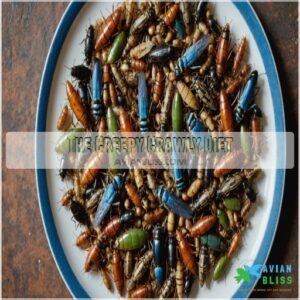



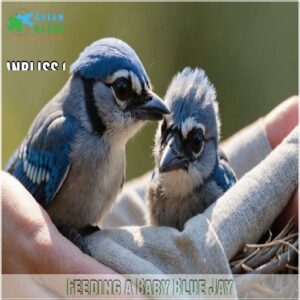
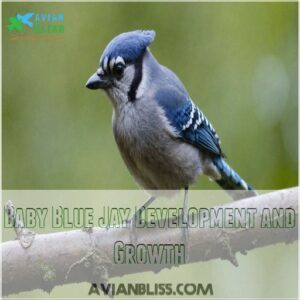
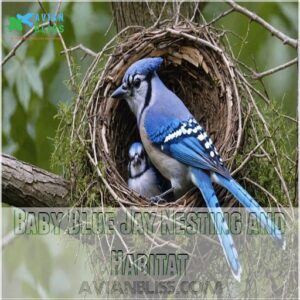

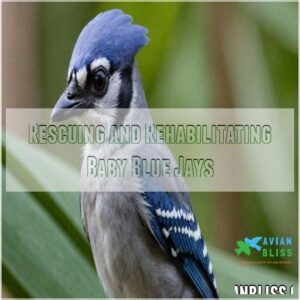
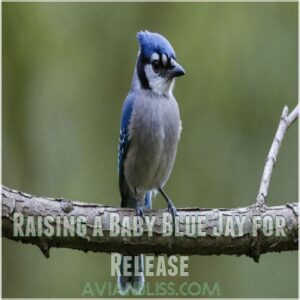
0 Comments